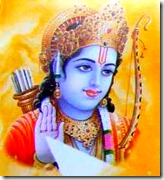 “In the same way that a golden jewelry box holds the most precious gem inside, while remembering the nirgunaaspect in the heart and keeping the saguna aspect in front of the eyes, place Shri Rama's supremely auspicious holy name on the tongue, says Tulsi.” (Dohavali, 7) “In the same way that a golden jewelry box holds the most precious gem inside, while remembering the nirgunaaspect in the heart and keeping the saguna aspect in front of the eyes, place Shri Rama's supremely auspicious holy name on the tongue, says Tulsi.” (Dohavali, 7)hiyam̐ nirguna nayananhi saguna rasanā rāma sunāma | manahum̐ puraṭa saṃpuṭa lasata tulasī lalita lalāma || The foremost religious practice, formal or otherwise, local or foreign, is that which brings about the highest transcendental taste, or rasa. In every area of activity there is sought after a taste, some direct interaction that brings pleasure. How then can spiritual life, deemed the eternal engagement, one that transcends the bounds of time and space, be lacking in transcendental pleasure resulting from the highest taste? Tulsidas herein says that the most auspicious name, orsunama, of Lord Rama, the Personality of Godhead, is the true gem in life, and it is safely guarded by two of the most popular and often misunderstood instruments for spiritual awakening found in the Vedic teachings, nirguna and saguna worship. One who is fortunate enough to taste the sweet and transcendental name of the Lord, which is non-different from His personal self, on their tongue will be most benefitted, as all of their spiritual practices from the current and previous lives will finally fructify into full blown bhava, or a return to the original nature of pure love and devotion to the Supreme Personality of Godhead. 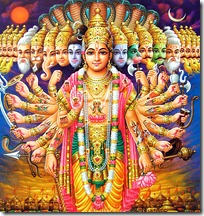 The taste of the holy name chanted on the tongue brings the Lord’s direct association, as it simultaneously evokes memories of the Divine’s other names, forms, attributes and pastimes. God’s original and most complete feature is described as Bhagavan, or one who possesses all fortunes. Bhagavan is not an ordinary person, though He has a personality and a level of intelligence. The workings of nature that we both observe and become baffled by, which nevertheless occur at regular intervals, are the result of careful consideration and decision made by the Lord and His direct associates. Though nature’s events operate on their own timetable, we can try to understand their purpose through observation and scientific study. But one who simply accepts the authority of the Vedas, the ancient scriptures of India, can very quickly reach the proper conclusion about life and the reason for its complexities. While it’s beneficial to be armed with knowledge, to experience a higher taste there must also be a change in behavior. For instance, we may have knowledge that going to a particular restaurant will enable us to eat a certain type of food, but if we don’t get up off the couch and actually make our way out of the house, we will never realize the benefit of that knowledge. In a similar manner, whether we refer to God as nature, death, or the Personality of Godhead, Bhagavan, if we don’t make use of the information handed down to us by past preceptors, the panacea offered by spiritual life will remain just a dream. The taste of the holy name chanted on the tongue brings the Lord’s direct association, as it simultaneously evokes memories of the Divine’s other names, forms, attributes and pastimes. God’s original and most complete feature is described as Bhagavan, or one who possesses all fortunes. Bhagavan is not an ordinary person, though He has a personality and a level of intelligence. The workings of nature that we both observe and become baffled by, which nevertheless occur at regular intervals, are the result of careful consideration and decision made by the Lord and His direct associates. Though nature’s events operate on their own timetable, we can try to understand their purpose through observation and scientific study. But one who simply accepts the authority of the Vedas, the ancient scriptures of India, can very quickly reach the proper conclusion about life and the reason for its complexities. While it’s beneficial to be armed with knowledge, to experience a higher taste there must also be a change in behavior. For instance, we may have knowledge that going to a particular restaurant will enable us to eat a certain type of food, but if we don’t get up off the couch and actually make our way out of the house, we will never realize the benefit of that knowledge. In a similar manner, whether we refer to God as nature, death, or the Personality of Godhead, Bhagavan, if we don’t make use of the information handed down to us by past preceptors, the panacea offered by spiritual life will remain just a dream.In the ignorant state, where the human being only sees God as being all-punishing death lurking around the corner, just waiting to come and take everything away, the activities taken up bring flickering happiness and no advancement in consciousness. The key distinction between a mature human being and an immature one is the level of knowledge possessed, which is acquired through both experience and the free passage of information from authority figures. When in the mature state, if consciousness remains wholly fixed upon objects of the phenomenal world, with no detachment, intelligence or information of the eternality of the soul present, the activities adopted won’t be any different from those of an animal, i.e. the behavior of the “knowledgeable” will mimic that of the ignorant. If both a human being and an animal have the same priority system for action, how are the two species any different? If God is really just nature consisting of innumerable movements of wind, elements and the sun, what is the use of becoming a human being? An animal lives the life of sense gratification with minimal impediment, and their fears are greatly mitigated as well. The dog doesn’t worry about a mortgage payment, divorce, or impending death. It simply does whatever it wants, whenever it wants. Only in the human species is there a chance to understand God, or a higher spiritual being to whom we are related. When the Supreme Being is not properly identified but at least somewhat acknowledged, there are different classes of religious activities taken to. The majority of the religiously inclined population of the world presently follows a system of worship that can be likened to what the Vedas refer to as devotion to the nirguna form. The Vedas describe the Absolute Truth, the one entity that is beyond the duality, illusion and limitation that is concomitant with a material existence, as both nirguna and saguna. Gunas are material qualities, or those elements which bind one to the cycle of birth and death. These descriptions of the Absolute Truth provided by the Vedas are not faulty in any way, but they are meant to be understood from the perspective of the conditioned eye. The Absolute Truth is always free of gunas, but in the conditioned state, we can view Him as having attributes – where He has a face, hands, legs, etc. - or we can see Him as being formless and all-pervading, a powerful beam of spiritual energy known as Brahman. Regardless of how one views Him, the Lord’s original position as Bhagavan, He who is infused with spiritual attributes, remains unchanged. The nirguna and saguna viewpoints are similar to how we say that the sun has risen or that the sun is not out today, but in fact the sun’s fiery properties and position have not changed at all, only the clarity of our vision has.
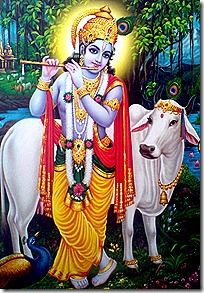 If one remains stuck on nirguna worship, their advancement towards complete purification of consciousness will be very troublesome. Though nirguna and saguna both refer to the Personality of Godhead, whose original form is described as being blackish and all-attractive, when only nirguna is understood, the transcendental features and sportive nature of Bhagavan are wholly ignored. As such, the sweet taste of the Lord’s association through a transcendental mellow, or rasa, can never be had. But the more detrimental aspect of not advancing past nirguna realization is that one becomes more prone to directing their natural loving propensities elsewhere. Nirguna worship can manifest in different ways; as it is practiced by the impersonalists claiming to follow Vedic traditions in India, the crux of the discipline involves meditation on that which is deemed formless. Maya, or material nature, is viewed as being false and Brahman as the only truth. Any interaction with maya therefore is the cause of bondage, and any meditation on formlessness accompanied by study of Vedanta philosophy is taken as worthwhile. Even in other spiritual traditions where maya and Brahman are not specifically addressed, since the worshipable object is similarly viewed as formless, there is a great impediment placed on the sincere worshipers. Dedicating yourself to nothing is very difficult; thus it becomes much easier to remain attached to worldly life. Amidst circles where religiosity is accepted and championed, the practices of animal slaughter, illicit sex and intoxication can only survive when the object of worship is considered formless or when His true identity is not revealed. If one remains stuck on nirguna worship, their advancement towards complete purification of consciousness will be very troublesome. Though nirguna and saguna both refer to the Personality of Godhead, whose original form is described as being blackish and all-attractive, when only nirguna is understood, the transcendental features and sportive nature of Bhagavan are wholly ignored. As such, the sweet taste of the Lord’s association through a transcendental mellow, or rasa, can never be had. But the more detrimental aspect of not advancing past nirguna realization is that one becomes more prone to directing their natural loving propensities elsewhere. Nirguna worship can manifest in different ways; as it is practiced by the impersonalists claiming to follow Vedic traditions in India, the crux of the discipline involves meditation on that which is deemed formless. Maya, or material nature, is viewed as being false and Brahman as the only truth. Any interaction with maya therefore is the cause of bondage, and any meditation on formlessness accompanied by study of Vedanta philosophy is taken as worthwhile. Even in other spiritual traditions where maya and Brahman are not specifically addressed, since the worshipable object is similarly viewed as formless, there is a great impediment placed on the sincere worshipers. Dedicating yourself to nothing is very difficult; thus it becomes much easier to remain attached to worldly life. Amidst circles where religiosity is accepted and championed, the practices of animal slaughter, illicit sex and intoxication can only survive when the object of worship is considered formless or when His true identity is not revealed.When the authorized deity form of the Personality of Godhead residing within the temple or the home is regularly offered obeisances, the practice is labeled as saguna worship, and it is considered more advanced because at least the nature of the Lord is better understood. The impersonalists, who take their mistaken conception of nirguna to be the ultimate feature of the Truth, view the devotees who follow saguna worship as less intelligent. “Maya is false and the cause of bondage. Since they are not intelligent enough to understand Vedanta philosophy, they are pretending to worship some form concocted out of resin or stone. Once they advance past this stage, once they gain detachment from material life, they can understand the all-pervading nature of the Absolute Truth and give up their saguna worship.” Indeed, when impersonalists encounter students who aren’t attracted to or can’t understand Vedanta, they recommend worship of any saguna form, irrespective of the authority of tradition or benefit of worship. “Just pick any form you like and worship it, for meditation, austerity and knowledge are the ultimate aims.” 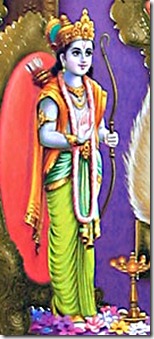 Due to their poor fund of knowledge, the misguided nirguna worshipers don’t understand that simply acquiring knowledge and renunciation doesn’t bring about a higher taste, as the active propensity of the eternal spiritual spark within the body is not addressed. At best, the nirguna worshipers can merge into Brahman, which is described as a beam of light emanating from the body of the original gigantic form of the Personality of Godhead. Yet since Brahman is formless and thus not an object, it cannot bring interaction. Even though it is superior to nirguna worship, there are still some deficiencies in strict saguna worship. Surely one is better able to understand that God is different from the living entities in terms of the magnitude of the attributes of beauty, wealth, strength, fame, knowledge, wisdom and renunciation possessed. Saguna worship also informs the devotee that God has an all-blissful personality that is full of form and capable of bringing tremendous satisfaction to those who choose to associate with it. Tulsidas elsewhere in his poetry nicely points out that the saguna aspect is simply the drawn out version of nirguna, a manifestation that removes all the seeds of doubt and any opportunity for being cheated by those who have misunderstood the nirguna aspect. Since the impersonalists consider themselves to be part of the Brahman effulgence, which is their highest realization of the Truth, they essentially equate themselves with God. When saguna worship is denied, it becomes easier for a charlatan to claim that he is God, for the features of the Supreme Lord have not been clearly defined. Due to their poor fund of knowledge, the misguided nirguna worshipers don’t understand that simply acquiring knowledge and renunciation doesn’t bring about a higher taste, as the active propensity of the eternal spiritual spark within the body is not addressed. At best, the nirguna worshipers can merge into Brahman, which is described as a beam of light emanating from the body of the original gigantic form of the Personality of Godhead. Yet since Brahman is formless and thus not an object, it cannot bring interaction. Even though it is superior to nirguna worship, there are still some deficiencies in strict saguna worship. Surely one is better able to understand that God is different from the living entities in terms of the magnitude of the attributes of beauty, wealth, strength, fame, knowledge, wisdom and renunciation possessed. Saguna worship also informs the devotee that God has an all-blissful personality that is full of form and capable of bringing tremendous satisfaction to those who choose to associate with it. Tulsidas elsewhere in his poetry nicely points out that the saguna aspect is simply the drawn out version of nirguna, a manifestation that removes all the seeds of doubt and any opportunity for being cheated by those who have misunderstood the nirguna aspect. Since the impersonalists consider themselves to be part of the Brahman effulgence, which is their highest realization of the Truth, they essentially equate themselves with God. When saguna worship is denied, it becomes easier for a charlatan to claim that he is God, for the features of the Supreme Lord have not been clearly defined.The main limitation with saguna worship materializes when the devotee is away from the temple or not in front of the original Lord, His deity, personal incarnation or picture representation. When we’re not in the temple, does it mean that God is not with us? The nirguna worshipers in this respect have a leg up, as they understand that Brahman is all-pervading. The saguna worshipers, through steady practice and devotion, may eventually come to this same realization, but it is very difficult if all one does is stare at a deity. When the deity is not present before the eyes, the worshiper again becomes prone to the effects of maya and her temptations. Maya, as the faithful servant of Bhagavan, lures the living entity infused with material desires into worshiping so many other things except God. Certainly God is everything, but His personal presence is not reflected in matter, at least not when the material elements are used for personal satisfaction. The deity, though composed of material elements, is considered spiritual because of how it is viewed and worshiped. God created the elements of nature after all, so if they are used for expanding knowledge of His divine grace, they cannot be considered illusory or harmful. 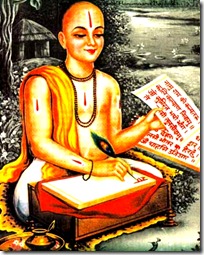 Tulsidas, ever the peacemaker and kind-hearted soul, in the above referenced verse from the Dohavali very nicely tries to bring both factions together, telling them that the sweetness of divine association can be found through keeping the auspicious name of Rama on the tongue. The impersonalists will say that Rama is simply a saguna manifestation of Brahman, but the Vedas accurately point out that He is an avatara, which means “one who descends”. For an individual to move, they must exist prior to their travel. Moreover, they must have intelligence and superior abilities. Rama is an incarnation of Lord Vishnu, the ever opulent and all-pervading Supreme Lord, a plenary portion of Lord Krishna, who is considered the original form of Godhead. Rama’s deity form can be found in many temples around the world and in pictures kindly worshiped in millions of homes, but His name is the real source of sweetness and the best way to connect with Him. Tulsidas, ever the peacemaker and kind-hearted soul, in the above referenced verse from the Dohavali very nicely tries to bring both factions together, telling them that the sweetness of divine association can be found through keeping the auspicious name of Rama on the tongue. The impersonalists will say that Rama is simply a saguna manifestation of Brahman, but the Vedas accurately point out that He is an avatara, which means “one who descends”. For an individual to move, they must exist prior to their travel. Moreover, they must have intelligence and superior abilities. Rama is an incarnation of Lord Vishnu, the ever opulent and all-pervading Supreme Lord, a plenary portion of Lord Krishna, who is considered the original form of Godhead. Rama’s deity form can be found in many temples around the world and in pictures kindly worshiped in millions of homes, but His name is the real source of sweetness and the best way to connect with Him.Tulsidas here asks the impersonalists to keep their precious nirguna form safely tucked away in the heart and the saguna worshipers to keep the deity form straight in front of their eyes. But to tie both pieces together, to really understand who the object of worship is, one must taste the name of the Lord on the tongue. Chanting Rama’s name is likened to the jewel in the golden box made up of nirguna and saguna worship, with the two styles of worship acting as the top and bottom covers. Indeed, this is an entirely valid comparison, as religious practices that are below bhakti, or devotional service, are ideally meant to lead up to the final stage of transcendental love, which is best exhibited through the chanting process. One who is expert in chanting surpasses the limitations of strict nirguna and saguna worship. Prahlada Maharaja, the five-year old son of the demon king Hiranyakashipu, chanted Lord Vishnu’s names and thought of Him all the time without ever having met Him. When thrown into a pit of fire and tossed off the side of a cliff, Prahlada simply meditated on Vishnu and His name and was thus saved. The impersonalists will say that he was focusing on the nirguna aspect, but since Prahlada understood who Bhagavan was after hearing from Narada Muni, even his apparent nirguna worship was perfect. Through chanting the Lord’s name, consciousness becomes purified, and from this the mind becomes the greatest friend, an agent for real change.  If we are stuck at work all day or in situations where we can’t worship the deity or meditate on the sacred syllable om, we can still chant the holy name, either out loud or at least within the mind. As such, the gem of spiritual practice is always there for the taking. One should enjoy the sweetness of the auspicious name of God as often as possible, following the rules and regulations prescribed by the Supreme Lord’s authorized representatives and their descendants. For the people of this age, the most sacred formula, the one series of words which contains the two most powerful names of the Lord, is the maha-mantra: “Hare Krishna Hare Krishna, Krishna Krishna, Hare Hare, Hare Rama Hare Rama, Rama Rama, Hare Hare”. The names in this mantra are the most valuable gems, so even if we are lucky enough to have a nice jewelry case or a large and sturdy golden box made up of meditation practices, we should still move forward with the next step that will allow us to see and experience the precious gem inside, the sweetness of transcendental association that is the chanting of the holy name. If we are stuck at work all day or in situations where we can’t worship the deity or meditate on the sacred syllable om, we can still chant the holy name, either out loud or at least within the mind. As such, the gem of spiritual practice is always there for the taking. One should enjoy the sweetness of the auspicious name of God as often as possible, following the rules and regulations prescribed by the Supreme Lord’s authorized representatives and their descendants. For the people of this age, the most sacred formula, the one series of words which contains the two most powerful names of the Lord, is the maha-mantra: “Hare Krishna Hare Krishna, Krishna Krishna, Hare Hare, Hare Rama Hare Rama, Rama Rama, Hare Hare”. The names in this mantra are the most valuable gems, so even if we are lucky enough to have a nice jewelry case or a large and sturdy golden box made up of meditation practices, we should still move forward with the next step that will allow us to see and experience the precious gem inside, the sweetness of transcendental association that is the chanting of the holy name. |
Search This Blog
Wednesday, June 8, 2011
The Gem in the Box
Subscribe to:
Post Comments (Atom)
No comments:
Post a Comment